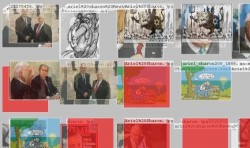trace: a mark or line left by something that has passed…
The Image Tracer is a collaborative project between Tsila Hassine and De Geuzen. It evolved out of our interests in media images and the way their significance and presence fluctuate in the ecology of the world wide web. Currently, in its beta phase, the Tracer is a research tool that archives Google image searches for the purposes of tracking their url, appearance, disappearance and rank.
Operating from a local hard disk, when an image search is performed, a python script structures the query results and saves them in a file, which is then uploaded into a database and converted into html or viewable pages. These html pages function like a snapshot in a given moment. When you re-perform the operation, another snapshot is layered over the previous capture, creating an archeology of data.
Test search: Ariel Sharon
This page shows the Image Tracer in an earlier stage, and is based on search data for “Ariel Sharon” accumulated over a longer period of time. Though many elements are not implemented in this version, you can see how image layers accumulate over time.
Image density builds and wanes through time, reflecting how long or little, a jpeg, gif or png has been online and how its rank shifts over time. Opacity denotes the consistent presence and position of an image through multiple searches, while more transparent or murky images have appeared for less time or moved in rank.
The Image Tracer archives images (which are downloaded and re-sized for easier manageability), the url, the date of query, filename, status and rank. At the moment, we are testing the reliability of the code and legibility of the interface, but in the future, we are planning to have the script freely available for download. This would make it possible to create a distributed archive of Google image searches which people could then study for their own purposes.
If you would like more detailed information, please consult our FAQ sheet, covering everything from practical information to theoretical concerns, technical specs, possible uses and potential further development.
